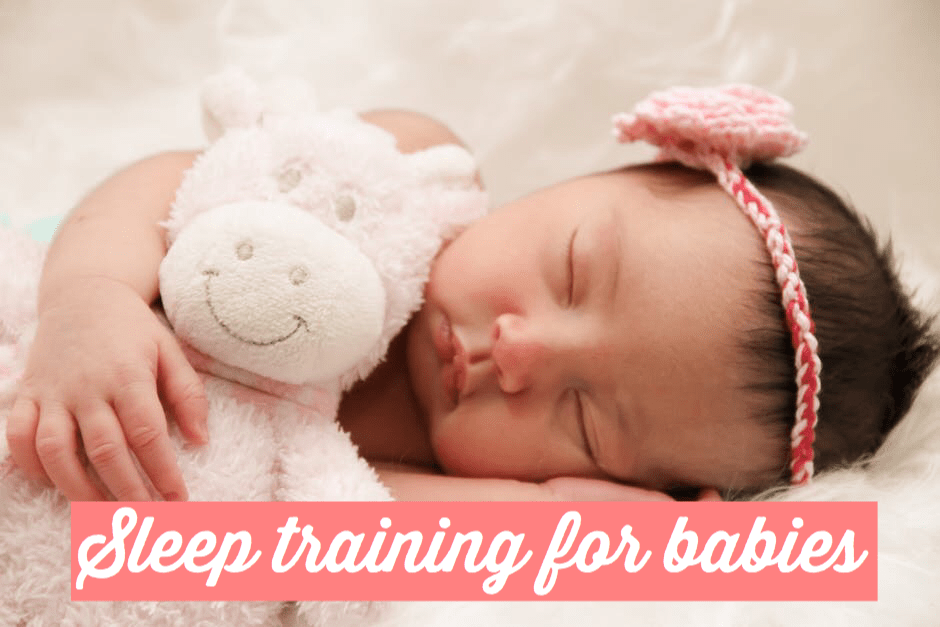You just had your baby, and everything is perfect, just the way you dream it. You are dying of tenderness and love for that little bundle of joy that keeps you awake 24/7. Say what? Yep, that’s right, the first months with a baby is the most wonderful experience in a woman’s life, It’s truly a blessing. But we can’t ignore the fact that the change is drastic. In this article we are going to talk about Sleep training for babies, we are going to talk about all the methods that exist to train your baby to sleep from an early age, and I will also give you the tips that helped me a lot to make my children sleep as early as 2 months old. Ready? Let’s begin!

What is sleep training?
The sleep training process is teaching your baby to be able to sleep alone and independently. It can be done in many ways, and in fact, there are many methods that have been studied for years to perform sleep training for babies. But, out of all these methods, you must choose the one that best suits your parenting style.
The American Academy of Sleep Medicine recommends infants age 4 to 12 months get between 12 to 16 hours of sleep during each 24-hour period, including naps., to reap the most health benefits from sleep. Children ages 1 to 2 years need 11 to 14 hours, and those ages 3 to 5 need 10 to 13 hours a day.
What is the perfect time for sleep training a baby?
The time recommended by the sleep consultant is from 4 to 6 months old. In this time most babies develop the ability to self-soothe and relax, which makes it easier for the sleep training process. Also, the feeding at night can be more spaced out, which also facilitates longer hours of sleep for your baby.
Obviously, you can start with sleep training from earlier. In fact, from day 1 your baby is learning from daily routines. They learn to associate the routine that facilitates sleep and routines that will keep them alert or awake.
Always before starting sleep training, consult the pediatrician, to be sure, that your baby is ready.
At this time, you have probably heard about sleep training at least once. After all, it is one of the most debated topics among mothers. It should be noted, that this is a topic of debate also for doctors and sleep consultant professionals by the delicate fact of letting your baby cry for a long time. It is safe or not? Well, let me break down the methods for you!
Most popular methods for baby sleep training.
Cry-it-out method.
This is one of the most debated methods by the scientific community. Because it’s about letting the baby cry until he is able to soothe himself and fall asleep. People who agree with this method say, that it is a practical way to teach infants how to fall asleep on their own. And it is also one of the fastest methods. That doesn’t take a long time for parents to see results. On the other hand, professionals who criticize this technique ensure that leaving a baby to cry indefinitely without calming it properly can cause psychological damage that will negatively affect your baby’s sense of security at bedtime.
From all the methods to sleep training, the Cry-it-out is the most aggressive. Because involves a lot of crying. For that reason, experts recommend waiting until the baby is at least 6 to 10 months old if you have to try it at all.
I personally try this method myself, and I didn’t like it. I suggest you start trying the other methods first, and see if any of them works better. Leave this one as the last resource.
Ferber method.
This technique has its name due to the pediatrician Dr. Richard Ferber. It is usually confused with the previous Cry-it-out technique, but it is not. In this technique, Dr. Ferber emphasizes that it is not about letting the baby cry for long periods of time without limits. On the contrary, in this method Ferber it is recommended to put the baby drowsy in his crib and go out of the room.
If the baby cries, wait a few minutes before going back to the room. In the course of 1 week, it is recommended to wait 3 minutes to enter the room the first day, and as the week goes by, increase the minutes you wait to enter daily, all the way up to 10 minutes, before attending to the baby. The technique is treated for at least 1 week, increasing the time gradually. At the end of the week, you can evaluate the results.
This method could be difficult for some moms because you are not supposed to engage with the baby when you check on him. The only way you can use to reassure him that everything is fine is by a love patting for 2-3 minutes. The goal of this method is NOT to help the baby fall asleep, so he can learn to do it on his own.
It’s recommended to start the Ferber methods at 4 to 6 months old.
Fading method.
The fading method is very gentle. It is about gradually shortening the routine you have in place to sleep your baby. For example: If you rock your baby every night until he falls asleep completely, in this technique you will be shortening that time to a few minutes max. This method promotes that your baby finishes sleeping alone in the crib, and eventually, he can sleep by himself without the need to be rocked.
You can start the fading method as soon as 6 to 8 weeks old.
Chair method.
The method of the chair is very simple but usually involves more cry and tears. In this method a chair is placed inside the baby’s room, the purpose of the chair is to be present in the room to calm the baby. But not to pick him up from the crib or to give him much attention. This method can be very difficult as well because you have to avoid engaging with your baby. The baby is put in the crib, and from afar you let him know that you are there, taking care of him until he falls asleep. Gradually, you move the chair away until it is completely out of the baby’s room. The purpose of this method is to promote that the baby gradually is able to soothe and fall sleep alone.
It’s recommended to start with this method when the baby is a bit older at 3 to 6 months old.
Wake-and-sleep method.
This method is proposed by Dr. Harvey Karp. This method promotes following a specific sleep routine, then taking the baby to his crib and waking him slightly before leaving him there. This way, the baby is acquiring the ability to fall asleep alone.
It’s basically, sleeps the baby with any sleep routine that you prefer. Such as feed, bathe, swaddle and rocking the baby for example, but before putting the baby in bed, wake him up, so he can go back to sleep on his own in the crib.
It’s recommended to start with this method when the baby is about 3 months old.
Pick-it-up-put-it-down sleep training technique.
It is exactly what the name says. It is a technique where you put the baby in the crib already drowsy. If he cries, you pick him up, comfort him until he is calm and drowsy again, and you put him back in the crib, until shortly he falls asleep. This method requires patience and consistency Is also considered a gentle method. Because involves very little tears and almost no crying.
It is recommended to start this method between 6 to 8 weeks of age.
No-cry-out methods.
There are other alternative methods to avoid cry-it-out methods.
These methods of No-cry-out, are usually effective but many times takes longer to work. The most recommended for this No-cry-out method is to avoid strict feeding, swaddling, and crib routines for infants because, in the same way, they are put to sleep, it is what they expect to happen at all times. Including, in the middle of the night, when you are super tired and need your baby or infant to be able to sleep on its own. In these No-cry techniques, experts recommend changing daily what you do with your baby to put him to sleep, always promoting that he sleeps on his own.
Within the No-cry-out methods, you have various, the most effective is the Fading method, Pick-it-up-put-it-down sleep training technique.
Related posts:
Newborn developmental milestones, first 3 months.
Normal child development at 24 months.
Child development, normal development by 12 months.
Under certain circumstances, doctors DON’T recommend Sleep training. Here you have a list of them:
- When the baby is still too young physically or developmentally. The recommended time is at least 4 months or more of age.
- When an existent medical condition needs to be addressed first with a professional.
Let’s take a look at why these recommendations exist.
Pediatricians Don’t Recommend Sleep Training Before 4 to 6 months old due to the following reasons:
Babies less than 4 to 6 months of age still require regular nighttime feedings. On average, babies at this age can only eat about 3 to 4 ounces of milk. In order to get enough calories to grow, they have to eat around the clock.
For those mommies who are ready to start a Sleep Training, here you have a sleep routine with some tips that helped me a lot to make my children sleep as early as 2 months old, this routine is the preparation for the sleep training process.
- Consistency is key: Maintaining the same time to perform your baby’s sleep routine is key. This will send positive association signals to the baby’s brain that will trigger the ability to engage with the routine at the time of sleep and actually fall asleep.
- Create the atmosphere: Turn down or dim the lights, turn off the electronic devices on the surroundings to reduce over-stimulation, put a white noise machine with relaxing music, give the baby a quick massage. All of these are incredible ideas to create an appropriate atmosphere to put your baby to sleep.
- A good bath to the baby: To start your baby’s sleep routine, you have to make baby’s welfare a priority. A warm bath, with relaxing products to help calm the baby, the soften pajamas. All of this will prepare him for bedtime.
- Feed the baby: Or what is the best know as Dream feeding is the best way to prevent hunger pains to wake up your baby before time. Make sure to burp him appropriately as well to avoid gases.
- Limit number of naps throughout the day: In the first months of life it is very difficult to achieve this, but as the baby grows, you should try to keep the baby awake during the day with intervals of feed and play, mixed with fewer naps. This way your baby is going to be tired and ready for bedtime.
- Swaddle the baby: Swaddling is the act of wrapping the baby fairly tightly in a blanket, in a specific way (similar to a burrito). Babies feel as cozy and snug as they did inside the mommy’s womb, they will also feel safe and protected, and you can tell that babies really seem to love the experience. For reading more about Swaddling your baby and all the pros and cons, read here.
- Rock the baby: A technique to sleep your baby that goes back many years, the years of our grandmothers. I used to love rocking my children when they were little for hours until they fell asleep, I am guilty of this. Today’s expert and sleep consultants suggestions says to rock less time your baby so you can place them on the crib before they fall asleep completely on your arms, that way you are promoting falling asleep on their own in the crib.
- Stay close in case they need reassurance for a couple of minutes.
Enjoy the post? feel free to share it with other mommies.

Final thoughts.
Whichever method you choose for sleep training your baby, the most important thing is that you should feel comfortable. If the methods of letting your baby cry are not for you, there are no problems, you can try other methods that do not require crying.
All caregivers of the baby must agree with the method chosen by the parents, and all must be doing the same to achieve the final goal, which is that your baby learns to regulate alone, and can eventually sleep longer hours as well.
And finally, but not certainly least, you need to know that most babies cry a little when they are placed in the crib or bassinet. Regardless, if you ever feel that your baby is crying more than usual or in a strange way, it is always advisable to check with the doctor for any symptoms of gastric reflux, gases, etc.
If you enjoy this post, feel free to share it and leave your comments here, have you try any of these methods? , or are you thinking of trying any of them? let me know. As usual thanks for reading, I see you next time.
Zadi, xo










Good day to you Zadi; It’s a pleasure yet again to see your beautiful work — it was awesome seeing the different methods you can use to help babies sleep and you gave some fantastic insight into what exactly Sleep Training means as well as what it entails; things to look out for and things to avoid, plus also gave basic information on where to get advice, and who is best to give the advice.
We certainly want to make sure that the babies rest safely so that they can continue to develop healthily and happily, and also because if the baby doesn’t sleep, no one gets any sleep hahaha
Good point dear, thank you so much.
Awww I am happy to hear Zadi <3 <3. Takecare and enjoy your day and the rets of your week lol
[…] Baby sleep training. The complete guide. […]
[…] Baby sleep training. The complete guide. […]
[…] Baby sleep training. The complete guide. […]
[…] Baby sleep training. The complete guide. […]
[…] Baby sleep training. The complete guide. […]
[…] Baby sleep training. The complete guide. […]
[…] Baby sleep training. The complete guide. […]
Thank you for the tips, this article is very helpful. Getting babies to sleep is hard, I am trying some of your tips right away.
I am glad to hear that. Thanks.
Oh my god, your tips are going to save my life and sanity. Thanks.
Thanks, I am glad to help.
[…] Baby sleep training. The complete guide. […]
[…] Baby sleep training. The complete guide. […]